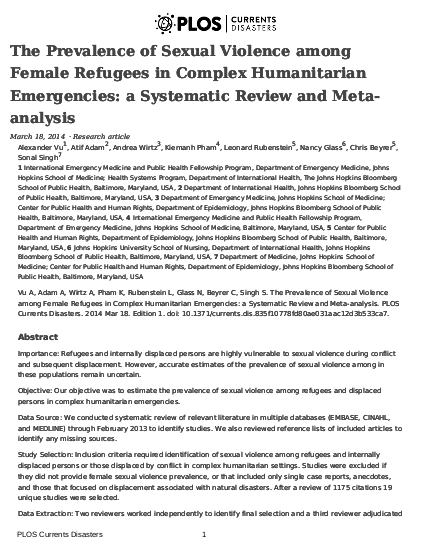
Importance: Refugees and internally displaced persons are highly vulnerable to sexual violence during conflict and subsequent displacement. However, accurate estimates of the prevalence of sexual violence among in these populations remain uncertain. Objective: Our objective was to estimate the prevalence of sexual violence among refugees and displaced persons in complex humanitarian emergencies. Data Source: We conducted systematic review of relevant literature in multiple databases (EMBASE, CINAHL, and MEDLINE) through February 2013 to identify studies. We also reviewed reference lists of included articles to identify any missing sources. Study Selection: Inclusion criteria required identification of sexual violence among refugees and internally displaced persons or those displaced by conflict in complex humanitarian settings. Studies were excluded if they did not provide female sexual violence prevalence, or that included only single case reports, anecdotes, and those that focused on displacement associated with natural disasters. After a review of 1175 citations 19 unique studies were selected. Data Extraction: Two reviewers worked independently to identify final selection and a third reviewer adjudicatedany differences. Descriptive and quantitative information was extracted; prevalence estimates were synthesized. Heterogeneity was assessed using I2. Main Outcomes: The main outcome of interest was sexual violence among female refugees and internally displaced persons in complex humanitarian settings. Results: The prevalence of sexual violence was estimated at 21.4% (95% CI, 14.9-28.7; I2=98.3%), using a random effects model. Statistical heterogeneity was noted with studies using probability sampling designs reporting lower prevalence of sexual violence (21.0%, 95% CI, 13.2-30.1; I2=98.6%), compared to lower quality studies (21.7%, 95% CI, 11.5-34.2; I2=97.4%). We could not rule out the presence of publication bias. Conclusions: The findings suggest that approximately one in five refugees or displaced women in complex humanitarian settings experienced sexual violence. However, this is likely an underestimation of the true prevalence given the multiple existing barriers associated with disclosure. The long-term health and social consequences of sexual violence for women and their families necessitate strategies to improve identification of survivors of sexual violence and increase prevention and response interventions in these complex settings.